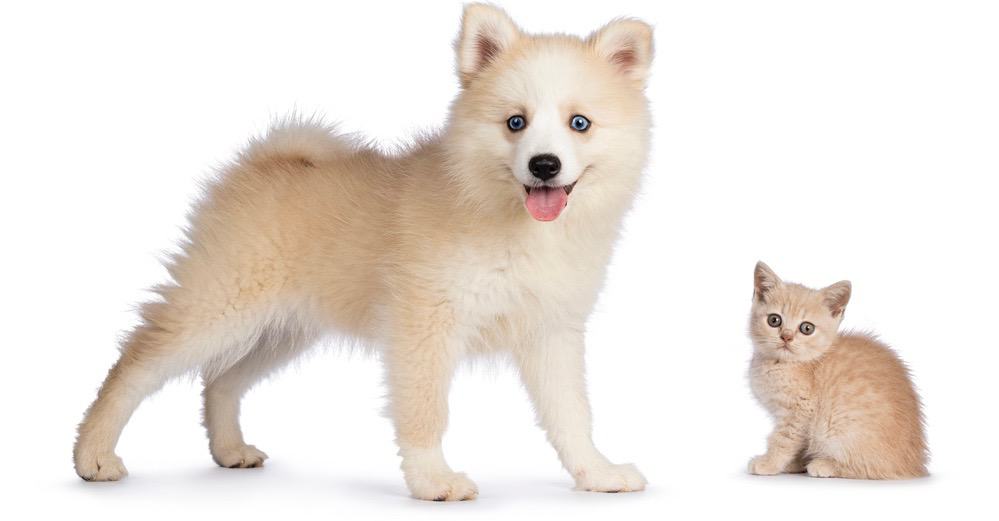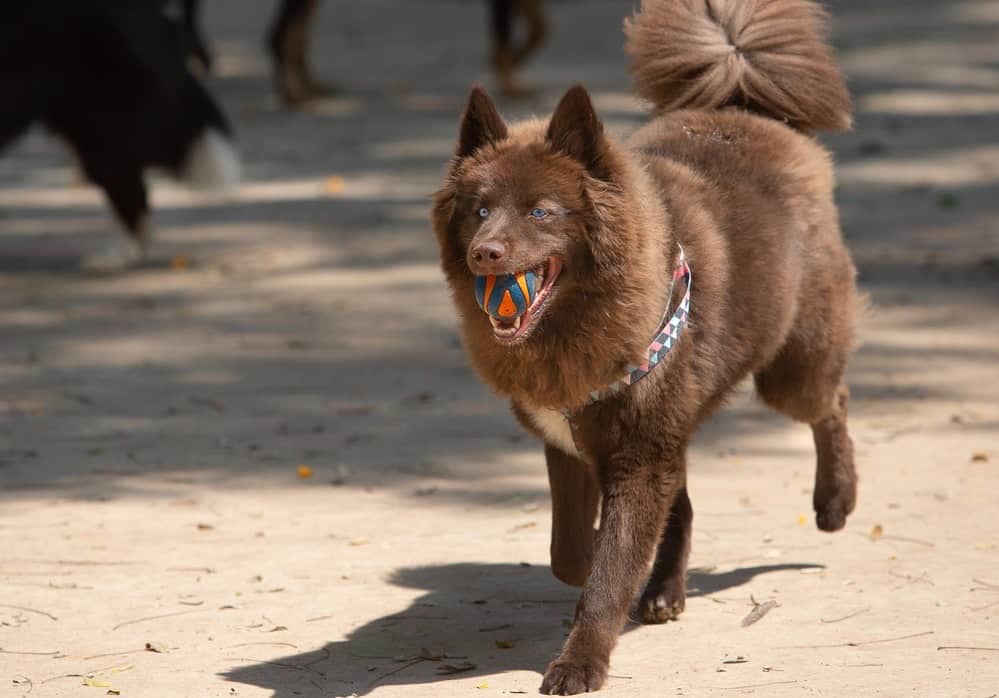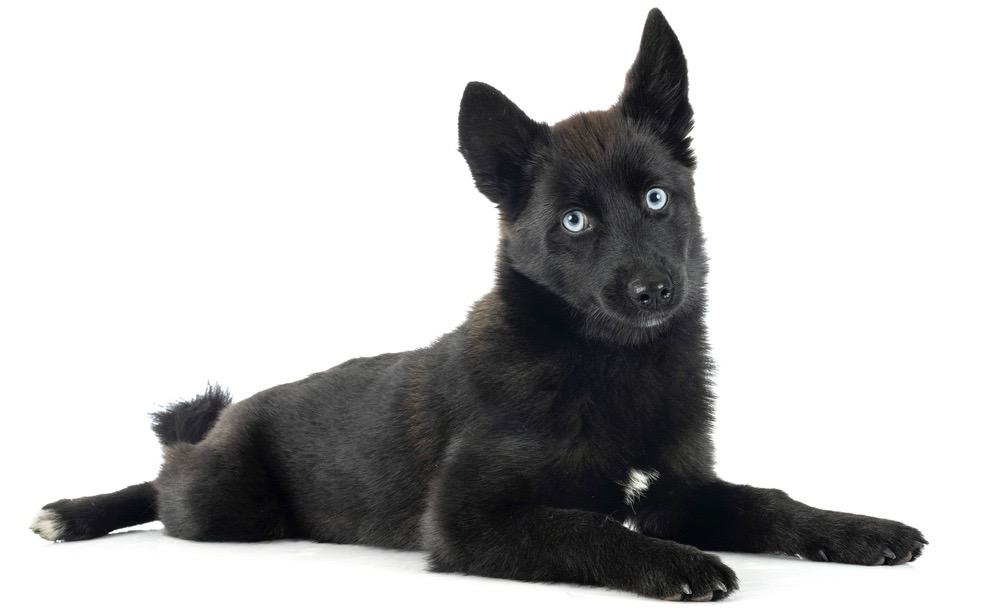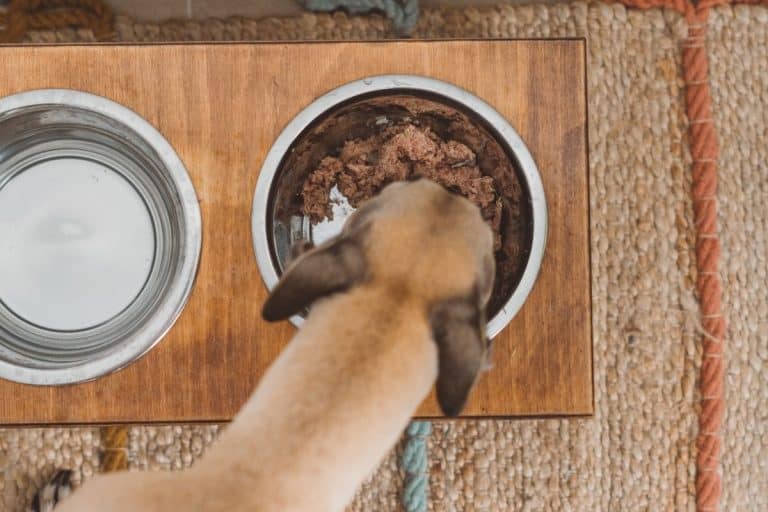Pomsky Growth Chart – Weight & Size Chart
The adorable, picture-perfect Pomsky is a result of breeding the Siberian Husky and the Pomeranian.
If you own a Pomsky or looking to get one, you must understand the Pomsky growth chart so that you can provide them with all they need to achieve optimal growth.
On average, an adult Pomsky stands at a height of between 10 and 15 inches and weighs between 20 to 30 pounds. The best way to know how big your Pomsky will get is to look at the parent’s size.
This article will provide you with all the facts about a Pomsky size chart, factors that can affect their growth, and what to expect as they grow.
When Is A Pomsky Full Grown?

Most Pomskies achieve their skeletal growth at around the age of one year. This means that they have reached their maximum height and their bones have reached their full length.
Most Pomskies will continue bulking up and adding muscle and fat to their frame until the age of 18 months.
Even though Pomskies may still be growing, they will reach their sexual maturity before their first birthday.
Both female and male Pomskies will start showing signs of sexual maturity at around the age of 6 to 9 months.
Therefore, be ready to deal with changes in behavior as the new hormones start taking effect. If you are not planning to show or breed your dog, then speak to your vet about neutering or spaying them.
As your puppy grows, do not expect their playfulness to go away, in fact, they will hold on to their fun-loving disposition as they grow because both of their parents are known to be active, inquisitive, friendly, and a bit mischievous.
By the time your Pomsky reaches the age of 18 months, they will be done growing, and they would have achieved their sexual, physical, and mental growth.
Pomsky Weight Chart
| Standard Pomsky | Large Pomsky | |
|---|---|---|
| Weight | 20 - 30 lbs | 30 - 50 lbs |
| Height | 13 - 18 inch | 18 - 24 inch |
| Full Grown | 10 - 12 months | 12 - 13 months |
If you are a Pomsky owner, you can track their weight using the Pomsky weight chart. This is to ensure that their weight is ideal and healthy throughout their stages of growth.
Your puppy’s weight can be affected by certain factors such as nutrition, health, genetics, and physical activity.
Therefore, providing them with a healthy diet, adequate exercise, and regular visits to the vet will ensure that they maintain a healthy weight for their age.
Huskies attain 50% of their adult weight at the age of 3 months and 70% by the age of 6 months.
They weigh between 18 to 30 pounds at 3 months, 26 to 43 pounds at 6 months, 34 to 57 pounds at 1 year, and 35 to 60 pounds as adults.
On the other hand, Pomeranians do most of their growing in the first 6 months and reach their adult weight at the age of one year.
They weigh between 1 to 2 pounds at 3 months, 2 to 5 pounds at 6 months, and 3 to 7 pounds as adults.
Pomskies experience significant growth in the first six months of their life.
Since they are a small breed dog, they will hit 50% of their weight between the ages of three and four months, then reach their adult weight at the age of 12 and 15 months.
How Big Do Pomskies Get?
The best way to find out the adult size of your Pomsky is to look at the size of their parents. Normally, Pomskies are produced with a larger mother and a smaller father.
Therefore, male Pomeranians and female Siberian Huskies are bred through artificial insemination. Generally, larger parents produce larger puppies and vice versa is true.

Another way to find how big your puppy will get is to consider their generation. The following are the different generations of Pomskies:
F1 Generation – puppies from breeding a purebred Pomeranian and purebred Siberian Husky.
F1B Generation – puppies from breeding a purebred Siberian Husky or Pomeranian and an F1 generation Pomsky.
F2 Generation – puppies from breeding two F1 generation Pomskies.
F2B Generation – puppies from breeding original parent breed and F2 generation Pomskies.
F3 generation and beyond – F3 generation refers to puppies from breeding two F2 generation Pomskies. The generations can go beyond this and are often referred to as multi-generational.
Another way of knowing the adult size of your puppy if you do not have access to the parents is to do a DNA test or look at their paws.
As adults, Pomskies have a weight of between 20 to 30 pounds and a height of between 10 to 15 inches.
Are There Different Sizes Of Pomsky?
Pomskies can come in different sizes and the variations are because of the massive difference between the weights and heights of the two parent breeds.
Pomeranians are classified as toy dogs while Siberian Huskies are a medium breed.

Therefore, most Pomskies will be considered as a small breed. Since genetics can be unpredictable, you may end up having a medium-sized Pomsky, so you need to be ready for this when choosing to buy or adopt this breed.
However, most Pomskies are the standard size and weight between 20 to 30 pounds.
Pomsky Growth Chart – What to Expect
Birth – 2 Weeks
This is the neonatal stage and your Pomsky puppy is fully dependent on the mother for nutrition and care.
If the mother is not present or cannot produce enough milk for the puppies, then puppy formula can be used as an alternative as it contains similar nutrients as the mother’s milk.
At this stage, the puppy’s ears and eyes are not open, so they spend most of their time sleeping and eating.

3 Weeks – 12 Weeks
At this stage, the puppy’s ears and eyes are opened and they start becoming aware of their surroundings. At five weeks their first teeth appear, start to bark, wag their tail, and walk.
You can start weaning the puppy at four weeks with liquid foods and at 8 weeks they can feed on solid foods as they transition to new homes.
This is the stage of socializing your puppy and vaccinating them.
4 Months – 6 Months
At this stage, your puppy starts showing their dominance, therefore, it is the right time to train them on obedience and other skills. At this stage, the puppy may also experience fear.
7 Months – 9 Months
This is the age that most Pomskies have reached their adult height, making it the right time to spay or neuter them if you are not planning to breed them. Speak to your vet about this.

10 Months – 12 Month
At this stage, most Pomskies have achieved their adult weight and height. Continuous training on social skills should continue to ensure that their relationship with you is fun and respectful.
Adult
Your Pomsky is considered an adult at the age of 18 months, and this is when they have matured mentally, physically, and sexually.
They remain playful, so you should provide them with the exercise they need to keep them busy and active.
They also need a balanced diet to ensure that they are getting all the necessary nutrients to live healthy and happy life.
Pomsky Size Chart
As adults, Pomskies stand at a height of between 10 to 15 inches. Knowing your puppy’s height will enable you to buy them the right kennel doors, accessories, and is often required if your dog participates in shows.
To find out your dog’s height, let them stand straight and locate their withers. Then, measure from the ground to the withers using a measuring tape and that is your dog’s height.
Will Neutering/Spaying My Pomsky Affect His Growth?
Spaying and neutering involve the surgical removal of the reproductive organs, testes for male dogs, and ovaries for female dogs.
Growth hormones depend on the reproductive hormones for signals especially when it comes to the closing of the growth plates.
Therefore, if you spay or neuter your Pomsky at an early age before they are sexually matured, they will grow taller than average.
It is recommended that you spay or neuter your Pomsky between the ages of 6 and 9 months, but you should speak to your vet to exactly when to do it.
There are benefits of spaying or neutering your dog. For females, spaying prevents pregnancy and reduces the risk of ovarian cancer.
For males, neutering prevents breeding, minimizes aggressive behavior, and reduces the risk of testicular cancer.
Factors That Affect Pomsky Puppy Growth
Genetics and Gender
Pomsky is a mix of Pomeranian and Siberian Husky, therefore they inherit everything from both parents, such as size, character, and temperament.
Therefore, ensure you are aware of your dog’s history and that of the parent breeds.
In addition, learn about the genetic disorders that your dog may inherit, including hip dysplasia, eye problems, hypothyroidism, and hair shedding syndrome as they can affect their growth.
Generally, male Pomskies are larger and taller than females.
Nutrition
Pomskies are playful and have a great deal of energy. Therefore, they need the right type of food to keep them going.
It is always good to know that Pomskies are different from their ancestral breeds and thus, have different nutritional needs.

Pomskies need a high-quality variety of dry kibble that supplements all their dietary needs.
However, if you are not sure which meal is the best for your dog, consult with your vet to ensure that your dog lives the healthiest and has a long life.
Physical Activity and Health
Pomsky needs a lot of exercise because they are very active dogs. They are highly trainable and clever; their owners may consider agility as an outlet for their physical and mental energy.
However, their exact requirements depend on the size, but most Pomskies need an hour for exercise every day.
Mini Husky vs Pomsky Size
Mini Husky can grow to a height of 12 to 16 inches and weigh between 15 and 35 pounds. On the other hand, a Pomsky can grow to a height of 10 to 15 inches depending on the dog’s sex and weigh anywhere from 20 to 30 pounds.
How To Properly Weigh And Measure A Pomsky
Weight
Use a pet scale to measure your Pomsky’s weight. Ensure the scale is on a flat surface and place your puppy on it, then read the number on the scale.
The following are tips to consider before weighing your Pomsky:
- Weigh your dog at the same time always.
- Weigh your dog before any drink or meal.
- Your dog should be dry when you weigh them.
- If your dog has a collar, ensure it is the same for every weigh-in.
Measurements
To measure the neck, put the tape measure in the position where the collar usually sits. Ensure that the collar is removed before taking the measurements.
To measure the chest:
- Let your Pomsky stand evenly on all four legs
- Hold the tape measure around the chest position directly behind the elbow points
- Run the tape measure vertically on both sides of the chest.
- Place the tape measure halfway at the abdomen between the start of the hindquarters and the end of the ribcage.
- For male Pomskies, ensure the prepuce is not contained in the measurements, instead, slide the measure forward.
Pomsky Genetics And Common Health Problems
Since Pomsky is a breed between the Husky and Pomeranian, they may inherit some of the conditions from the two breeds.
Pomeranians suffer from dental issues because of the buildup of plaque. Your Pomsky may also suffer from the same condition, so a regular dental checkup for your dog is needed.
The Husky genes might be responsible for hip dysplasia and eyes conditions.
Your dog’s lineage can hint you on the hereditary diseases to expect, so it is recommended that you get your Pomsky’s lineage ratio from the breeder.
The best option is to take your Pomsky to the vet for examinations so that any health condition can be diagnosed and treated in its early stages.
Do your part of ensuring that your Pomsky eats healthy and gets plenty of exercise to ensure that they remain healthy.






